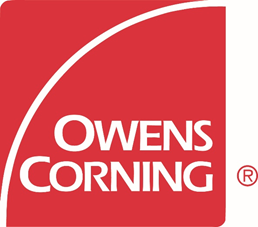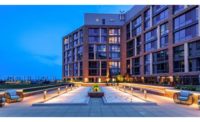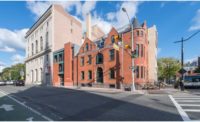A hospital with a legacy of care spanning more than 150 years trusts Owens Corning® Thermafiber® RainBarrier® mineral wool insulation to help manage muggy Midwest summers and bone chilling winters. While the Sidney & Lois Eskenazi Hospital is one of Indiana’s newest hospitals, the award-winning health care campus is deeply rooted in Indianapolis’s history. Founded as Indianapolis City Hospital in 1859, the hospital was also used during the Civil War to care for roughly 13,000 sick and wounded Union soldiers. It re-opened in December 2013, with a new name and entirely new facilities located just a half-mile West of the original campus.
The hospital’s legacy of care continues today with programs that advance sustainability and wellness. Certified in 2015 as Indiana’s first LEED Gold building– and one of the largest LEED Gold healthcare campuses in the world – the hospital is home to a green roof and sky farm, and an air filtration system that draws in outside air, which is treated, conditioned, filtered, and used only once before exiting the hospital. Outdoor green spaces provide community space for staff, patients and community members to enjoy and contemplate the wellness-minded amenities.
Among the nature-inspired amenities, water features play a vital role in the hospital’s design. Water features include a rainwater harvesting system that supplies 100 percent of the campus’s irrigation needs. Moisture management is also integrated into the design of the hospital enclosure; specifically, the exterior wall assembly and the insulation that helps repel moisture from incidental intrusion while reducing thermal bridging.
Owens Corning® Thermafiber® RainBarrier® 45 mineral wool insulation was installed to help manage liquid and moisture vapor throughout the enclosure. Addressing how moisture influences comfort and energy efficiency is a pre-requisite to achieving a high-performing enclosure. Installed as a continuous insulation behind the facade, the mineral wool insulation helps to efficiently repel incidental moisture from the wall cavity system. It also reduces thermal bridging and increases overall R-value, while also providing fire-resistant properties.
David Williams, senior project manager, Quality Interiors, Inc., was onsite during the hospital’s construction and witnessed firsthand how mineral wool stood up to drenching rains during the project’s completion. “We had our own version of a Midwest monsoon come through and I received a call from the hospital’s transition team saying they were worried a lot of the job site material was getting wet -- including the insulating material,” Williams recalls. He alleviated the caller’s concerns, noting that the product – RainBarrier®- was literally living up to its name. “I said, ‘Are you kidding? It’s designed to repel water,” Williams recalls. By the time hospital transition team members arrived at the jobsite to check out the effects of the rainfall, the material had completely dried out.
Mineral wool insulation’s ability to manage both liquid and vapor moisture is especially important in helping keep water from being trapped inside the wall cavity. With a minimal sorption of just 0.03%, even in the harsh climatic conditions measured by ASTM C1104 (120◦F, 95% humidity for 96 hours), Thermafiber® RainBarrier® mineral wool insulation delivers consistent thermal performance throughout the thickness of the mineral wool. And when the material does get wet, its specially engineered properties help it quickly revert to a dry state, as observed on the Eskenazi Hospital jobsite. The ability to repel moisture and revert to a dry state following moisture exposure, makes mineral wool a solid choice for continuous insulation in the exterior assembly.
Mineral wool also simplifies installation of continuous air and water barriers. By serving as a continuous, uninterrupted insulating material, the air and water barrier can also be installed in the exterior cavity with minimal penetrations of the material.
At a time when much attention is focused on the front-lines of health care, mineral wool provides important protection behind the scenes – specifically behind the façade of the healthcare enclosure. A When it comes to managing moisture, following are five benefits that Owens Corning® Thermafiber® RainBarrier® mineral wool delivers to healthcare enclosures.
Vapor permeability
By allowing vapor to flow through the assembly, a properly designed and insulated wall prevents moisture from becoming trapped inside where it can condense, collect and lead to problems ranging from mold to structural damage. At roughly 50 perms (per ASTM E96) Thermafiber® RainBarrier® mineral wool ci provides a high level of vapor permeance. Mineral wool offers design flexibility to help specifiers achieve performance goals depending on the aesthetic, location and purpose of the facility. Regardless of climate zone, a vapor permeable ci installed with an appropriate air barrier product or interior vapor retarding membrane allows designers to achieve a vapor permeable or impermeable exterior wall assembly.
Engineered for performance
An interesting aspect of mineral wool is that it can be engineered and manufactured to take on various performance properties – including moisture repellency to support a high-performing enclosure that maintains thermal performance. As any moisture that remains inside insulation as temperatures cool will reduce its R-value thermal performance, it is important that mineral wool used as a continuous insulation be engineered not to absorb water vapor when subjected to high heat and humidity. Thermafiber® RainBarrier® has a minimal sorption of just 0.03%, even in harsh, hot and humid environmental conditions such as those measured by ASTM C1104 (120◦F, 95% humidity for 96 hours). Additionally, the sorption property is consistent throughout the thickness of the mineral wool ci.
Compressive strength
A wide range of compressive strengths in the Thermafiber® RainBarrier® mineral wool insulation portfolio makes it easy for AEC professionals to tailor the specification to the design of the enclosure and the performance desired for the application.
Environmental sustainability
Thermafiber® RainBarrier® mineral wool products contribute to sustainability, energy conservation, and LEED credit categories; and are manufactured with a minimum 70% recycled content.
Sound performance
Thermafiber® RainBarrier® helps keep unwanted environmental noise from migrating into the building’s interior, contributing to a more peaceful and restful atmosphere.
As Eskenazi Hospital and healthcare applications across the U.S. demonstrate, the versatility of mineral wool makes it an effective insulation for managing comfort and thermal performance.
© Owens Corning 2021. All rights reserved.




